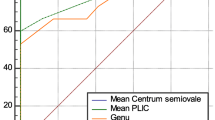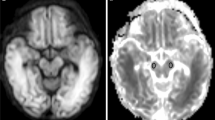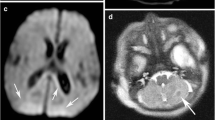Abstract
Background
The diagnostic and prognostic assessment of newborn infants with hypoxic-ischemic encephalopathy (HIE) comprises, among other tools, diffusion-weighted imaging (DWI) and apparent diffusion coefficient (ADC) maps.
Objective
To compare the ability of DWI and ADC maps in newborns with HIE to predict the neurodevelopmental outcome at 2 years of age.
Materials and methods
Thirty-four term newborns with HIE admitted to the Neonatal Intensive Care Unit of Modena University Hospital from 2004 to 2008 were consecutively enrolled in the study. All newborns received EEG, conventional MRI and DWI within the first week of life. DWI was analyzed by means of summation (S) score and regional ADC measurements. Neurodevelopmental outcome was assessed with a standard 1–4 scale and the Griffiths Mental Developmental Scales - Revised (GMDS-R).
Results
When the outcome was evaluated with a standard 1–4 scale, the DWI S scores showed very high area under the curve (AUC) (0.89) whereas regional ADC measurements in specific subregions had relatively modest predictive value. The lentiform nucleus was the region with the highest AUC (0.78). When GMDS-R were considered, DWI S scores were good to excellent predictors for some GMDS-R subscales. The predictive value of ADC measurements was both region- and subscale-specific. In particular, ADC measurements in some regions (basal ganglia, white matter or rolandic cortex) were excellent predictors for specific GMDS-R with AUCs up to 0.93.
Conclusions
DWI S scores showed the highest prognostic value for the neurological outcome at 2 years of age. Regional ADC measurements in specific subregions proved to be highly prognostic for specific neurodevelopmental outcomes.





Similar content being viewed by others
References
Pierrat V, Haouari N, Liska A et al (2005) Prevalence, causes, and outcome at 2 years of age of newborn encephalopathy: population based study. Arch Dis Child Fetal Neonatal Ed 90:F257–F261
Barkovich AJ, Hajnal BL, Vigneron D et al (1998) Prediction of neuromotor outcome in perinatal asphyxia: evaluation of MR scoring systems. AJNR Am J Neuroradiol 19:143–149
Miller SP, Ramaswamy V, Michelson D (2005) Patterns of brain injury in term neonatal encephalopathy. J Pediatr 146:453–460
Triulzi F, Parazzini C, Righini A (2006) Patterns of damage in the mature neonatal brain. Pediatr Radiol 36:608–620
Alderliesten T, de Vries LS, Benders MJ et al (2011) MR imaging and outcome of term neonates with perinatal asphyxia: value of diffusion-weighted MR imaging and 1H MR spectroscopy. Radiology 261:235–242
Barkovich AJ, Miller SP, Bartha A et al (2006) MR imaging, MR spectroscopy, and diffusion tensor imaging of sequential studies in neonates with encephalopathy. AJNR Am J Neuroradiol 27:533–547
Mader I, Schöning M, Klose U et al (2002) Neonatal cerebral infarction diagnosed by diffusion-weighted MRI: pseudonormalization occurs early. Stroke 33:1142–1145
Ment LR, Bada HS, Barnes P et al (2002) Practice parameter: neuroimaging of the neonate: report of the Quality Standards Subcommittee of the American Academy of Neurology and the Practice Committee of the Child Neurology Society. Neurology 58:1726–1738
Rutherford M, Counsell S, Allsop J et al (2004) Diffusion-weighted magnetic resonance imaging in term perinatal brain injury: a comparison with site of lesion and time from birth. Pediatrics 114:1004–1014
Rutherford M, Malamateniou C, McGuinness A et al (2010) Magnetic resonance imaging in hypoxic-ischaemic encephalopathy. Early Hum Dev 86:351–360
McKinstry RC, Miller JH, Snyder AZ et al (2002) A prospective, longitudinal diffusion tensor imaging study of brain injury in newborns. Neurology 59:824–833
Barkovich AJ, Westmark KD, Bedi HS et al (2001) Proton spectroscopy and diffusion imaging on the first day of life after perinatal asphyxia: preliminary report. AJNR Am J Neuroradiol 22:1786–1794
Twomey E, Twomey A, Ryan S et al (2010) MR imaging of term infants with hypoxic-ischaemic encephalopathy as a predictor of neurodevelopmental outcome and late MRI appearances. Pediatr Radiol 40:1526–1535
Thayyil S, Chandrasekaran M, Taylor A et al (2010) Cerebral magnetic resonance biomarkers in neonatal encephalopathy: a meta-analysis. Pediatrics 125:e382–e395
Griffiths R (1970) The abilities of young children. Child Development Research Centre, London
Liauw L, van Wezel-Meijler G, Veen S et al (2009) Do apparent diffusion coefficient measurements predict outcome in children with neonatal hypoxic-ischemic encephalopathy? AJNR Am J Neuroradiol 30:264–270
Oishi K, Mori S, Donohue PK et al (2011) Multi-contrast human neonatal brain atlas: application to normal neonate development analysis. Neuroimage 56:8–20
Amiel-Tison C, Grenier A (1986) Neurological assessment during the first year of life. Oxford University Press, Oxford
Towen BCL (1976) Neurological development in infancy. Mac Keith Press, London
Ferrari F, Gallo C, Pugliese M et al (2012) Preterm birth and developmental problems in the preschool age. Part I: minor motor problems. J Matern Fetal Neonatal Med 25:2154–2159
Sarnat HB, Sarnat MS (1976) Neonatal encephalopathy following fetal distress: a clinical and electroencephalographic study. Arch Neurol 33:696–705
Arrigoni F, Parazzini C, Righini A et al (2011) Deep medullary vein involvement in neonates with brain damage: an MR imaging study. AJNR Am J Neuroradiol 32:2030–2036
Rutherford MA, Pennock JM, Counsell SJ et al (1998) Abnormal magnetic resonance signal in the internal capsule predicts poor neurodevelopmental outcome in infants with hypoxic-ischemic encephalopathy. Pediatrics 102:323–328
Martinez-Biarge M, Diez-Sebastian J, Kapellou O et al (2011) Predicting motor outcome and death in term hypoxic-ischemic encephalopathy. Neurology 76:2055–2061
Barnett A, Mercuri E, Rutherford M et al (2002) Neurological and perceptual-motor outcome at 5–6 years of age in children with neonatal encephalopathy: relationship with neonatal brain MRI. Neuropediatrics 33:242–248
de Vries LS, Jongmans MJ (2010) Long-term outcome after neonatal hypoxic-ischaemic encephalopathy. Arch Dis Child Fetal Neonatal Ed 95:F220–F224
Conflicts of interest
None
Author information
Authors and Affiliations
Corresponding author
Rights and permissions
About this article
Cite this article
Cavalleri, F., Lugli, L., Pugliese, M. et al. Prognostic value of diffusion-weighted imaging summation scores or apparent diffusion coefficient maps in newborns with hypoxic-ischemic encephalopathy. Pediatr Radiol 44, 1141–1154 (2014). https://doi.org/10.1007/s00247-014-2945-9
Received:
Revised:
Accepted:
Published:
Issue Date:
DOI: https://doi.org/10.1007/s00247-014-2945-9




